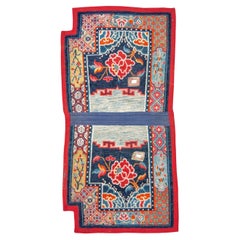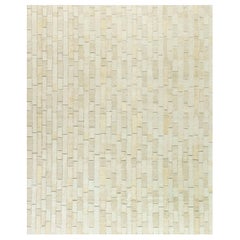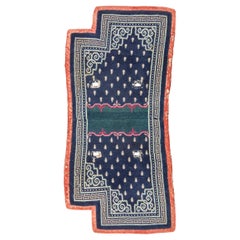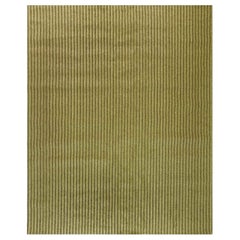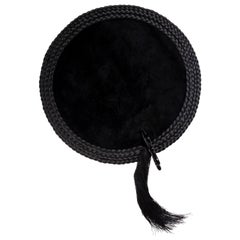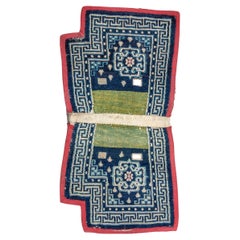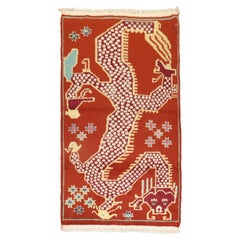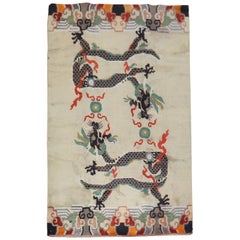Leather Chinese and East Asian Rugs
to
Width
to
Length
to
3
3
3
2
1
3
1
35,878
5,389
5,048
534
439
5
1
6
6
6
5
3
3
2
1
1
Material: Leather
Tibetan Saddle Rug, Early 20th Century
Located in San Francisco, CA
Tibetan Saddle Rug, Early 20th Century
Additional Information:
Dimensions: 4'6" L x 2'4" W
Period: Early 20th Century
Origin: Tibet
Condition: Exce...
Category
Early 20th Century Chinese Leather Chinese and East Asian Rugs
Materials
Leather, Wool
Contemporary Textural Wool, Silk and Leather Rug by Doris Leslie Blau
Located in New York, NY
Contemporary textural wool, silk and leather rug by Doris Leslie Blau.
Size: 12.1" × 15.1" (368 × 459 cm).
A hand-made modern area rug with a uniquely rich texture. It alternates cre...
Category
21st Century and Contemporary Indian Modern Leather Chinese and East Asian Rugs
Materials
Leather, Wool, Silk
Tibetan Saddle Rug, Late 19th Century
Located in San Francisco, CA
Tibetan Saddle Rug, Late 19th Century
An elegant and quite regal saddle rug from Tibet. The sparse nature of the patterning with the ‘frog’s foot’ pattern...
Category
Late 19th Century Chinese Antique Leather Chinese and East Asian Rugs
Materials
Leather, Wool
Contemporary Striped Twisted Belts Leather Rug by Doris Leslie Blau
Located in New York, NY
Contemporary striped twisted belts leather rug by Doris Leslie Blau.
Size: 12'1" × 14'10" (368 × 452 cm).
Handmade braided leather rug. Custom colors and sizes available.
This stunni...
Category
21st Century and Contemporary Portuguese Modern Leather Chinese and East Asian Rugs
Materials
Leather
Black Tie carpet, Hand-Knot in Silk, Leather and Ceramic, 100 Kpi, Nika Zupanc
By Nika Zupanc
Located in Milan, Lombardy
This is a rug with a decidedly feminine flavor that combines three materials: silk, leather and ceramic. The rug is entirely knotted in silk and has an outer band 15 cm lower than the central body, on which a leather braid is produced, produced in Tuscany. Everything is finished with a large ceramic bow...
Category
2010s Nepalese Modern Leather Chinese and East Asian Rugs
Materials
Ceramic, Leather, Silk
Antique Tibetan Saddle Rug, Late 19th Century
Located in San Francisco, CA
Antique Tibetan Saddle Rug/Blanket, Late 19th Century
Additional Information:
Dimensions: 4'0" L x 2'0" W
Origin: Tibet
Period: Late 19th Century
Category
Late 19th Century Chinese Antique Leather Chinese and East Asian Rugs
Materials
Leather, Wool
Related Items
Dragon Vintage Tibetan Rug
Located in New York, NY
Colorful one-of-a-kind Tibetan rug from the 3rd quarter of the 20th century with a dragon motif
Measures: 3'4'' x 5'7''.
Category
Late 20th Century Folk Art Leather Chinese and East Asian Rugs
Materials
Wool
Dragon Tibetan Vintage Rug
Located in New York, NY
A 3rd quarter of the 20th-century Tibetan rug with a dragon motif on a beige field
Size: 4'4'' x 6'10''.
Category
Late 20th Century Tibetan Tang Leather Chinese and East Asian Rugs
Materials
Wool
Exquisite 19th Century Antique East Turkestan Khotan Rug
Located in New York, NY
Early 20th century colorful antique Khotan gallery rug. The field is a bone color, denim blue, rust accents are dominant.
Measures: 5'8" x 12'11".
Category
Early 20th Century Turkmen Khotan Leather Chinese and East Asian Rugs
Materials
Wool
Vintage Tibetan Floral Rug
Located in New York, NY
Colorful late 20th century Tibetan rug with a lovely floral design
Measures: 2'11'' x 5'9".
Category
Late 20th Century Tibetan Chinese Export Leather Chinese and East Asian Rugs
Materials
Wool
Early 20th Century Chinese Tibetan Saddle Cover ( 2'6" x 4'2" - 76 x 127 )
Located in New York, NY
Early 20th Century Chinese Tibetan Saddle Cover ( 2'6" x 4'2" - 76 x 127 )
Category
1910s Chinese Tibetan Vintage Leather Chinese and East Asian Rugs
Materials
Wool
Kandinsky Rug Silk Late 20th Century
Located in Ferrara, IT
This Kandinsky silk rug from the late 20th century stands as a testament to abstract brilliance. Compact at 122 x 99 cm, it encapsulates Kandinsky's avant-garde vision in a tangible ...
Category
Late 20th Century Chinese Art Deco Leather Chinese and East Asian Rugs
Materials
Silk
Vintage Chinese Floral Needlepoint Rug with French Country Style
Located in Dallas, TX
77206 vintage Chinese floral needlepoint rug with French Country style. Various flower species grace the windows of an all-over compartment sty...
Category
Late 20th Century Chinese Country Leather Chinese and East Asian Rugs
Materials
Wool
Zabihi Collection Bright Orange Dragon Vintage Tibetan Rug
Located in New York, NY
a 3rd quarter of the 20th century bright orange color Tibetan rug
Details
rug no. j3229
size 3' x 5' 9" (91 x 175 cm
Category
Late 20th Century Tibetan Adirondack Leather Chinese and East Asian Rugs
Materials
Wool
Zabihi Collection Pink Floral Tibetan Rug
Located in New York, NY
1930s Tibetan floral rug in a soft pink tone
Details
rug no. j3568
size 3' x 4' 9" (91 x 145 cm)
Category
Early 20th Century Tibetan Tang Leather Chinese and East Asian Rugs
Materials
Wool
Modern Tibetan Rug
Located in New York, NY
A modern Tibetan rug from the 21st century with silk highlights inspired by western design and architecture.
Measures: 3' 2" x 4' 11"
Category
21st Century and Contemporary Tibetan Modern Leather Chinese and East Asian Rugs
Materials
Wool, Silk
Tree And Cloud Lilac Wool and Silk Chinese Inspired Area Rug by Joseph Carini
Located in New York, NY
Tree and Cloud is a mainstay Carini Carpets signature design by Joseph Carini. This is the lilac rendition, featuring a soft and delicate pink background with a hint of purple. The l...
Category
21st Century and Contemporary Nepalese Modern Leather Chinese and East Asian Rugs
Materials
Wool, Silk
$32,130
W 126 in L 180 in
Indigo Blue and Gold Hand Knotted Wool Tiger Accessory Carpet by Joseph Carini
Located in New York, NY
This Tiger rug embodies a traditional and versatile pattern, both contemporary and timelessly classic. Shown in gold and indigo, colored with vegetable dyes. Joseph Carini was inspir...
Category
2010s Nepalese Tibetan Leather Chinese and East Asian Rugs
Materials
Wool
Recently Viewed
View AllMore Ways To Browse
Vintage Garden Swing
Vintage Glass Boot
Vintage Hollywood Glamour Furniture
Vintage Irish Porcelain
Vintage Linen Cocktail Napkins
Vintage Mexican Pottery Bird
Vintage Oyster Plate France
Vintage Perfume With Atomizers
Vintage Santini Sculpture
Vintage Statton Furniture
Vintage Storage Box With Lid
Vintage Storage Boxes With Lids
Vintage Towel Cabinet
Vintage Wood Record Cabinet
Vintage Wood Stereo Cabinet
Virginia Mahogany
Wall Mounted Dry Bar
Wallace Aegean Weave
